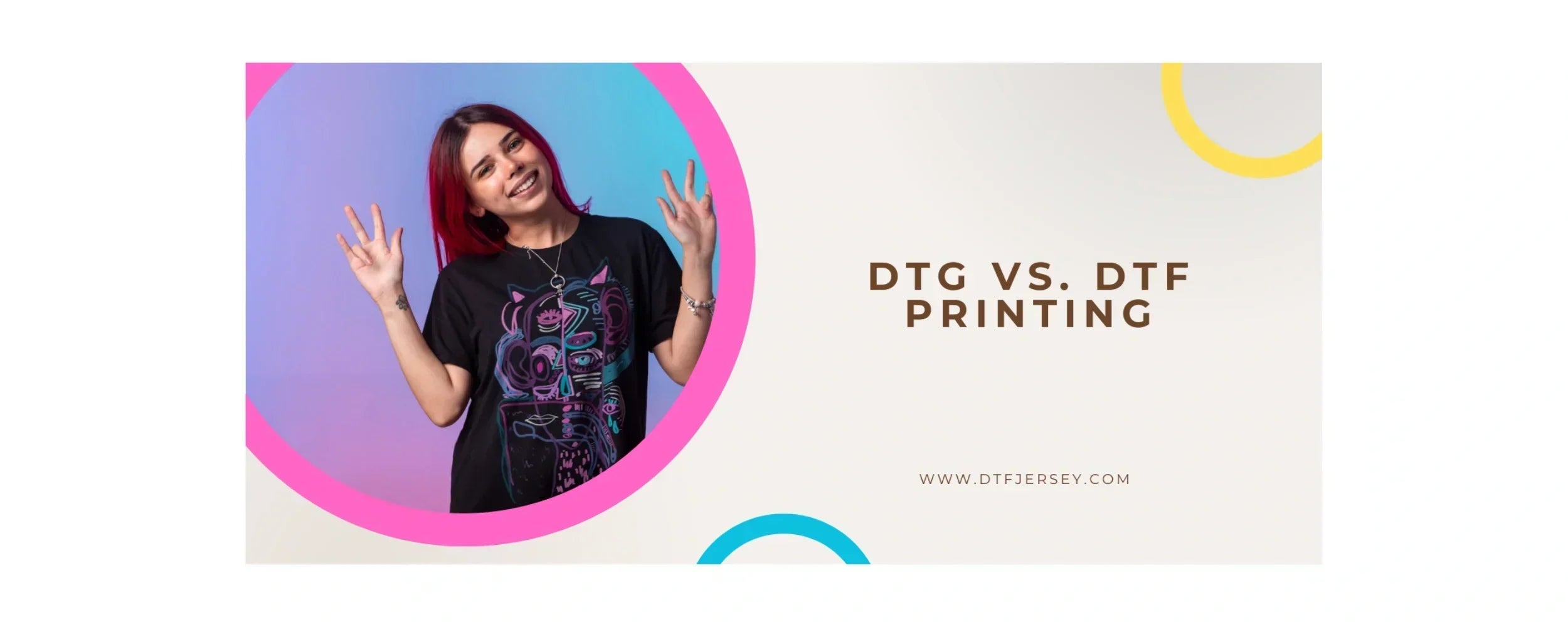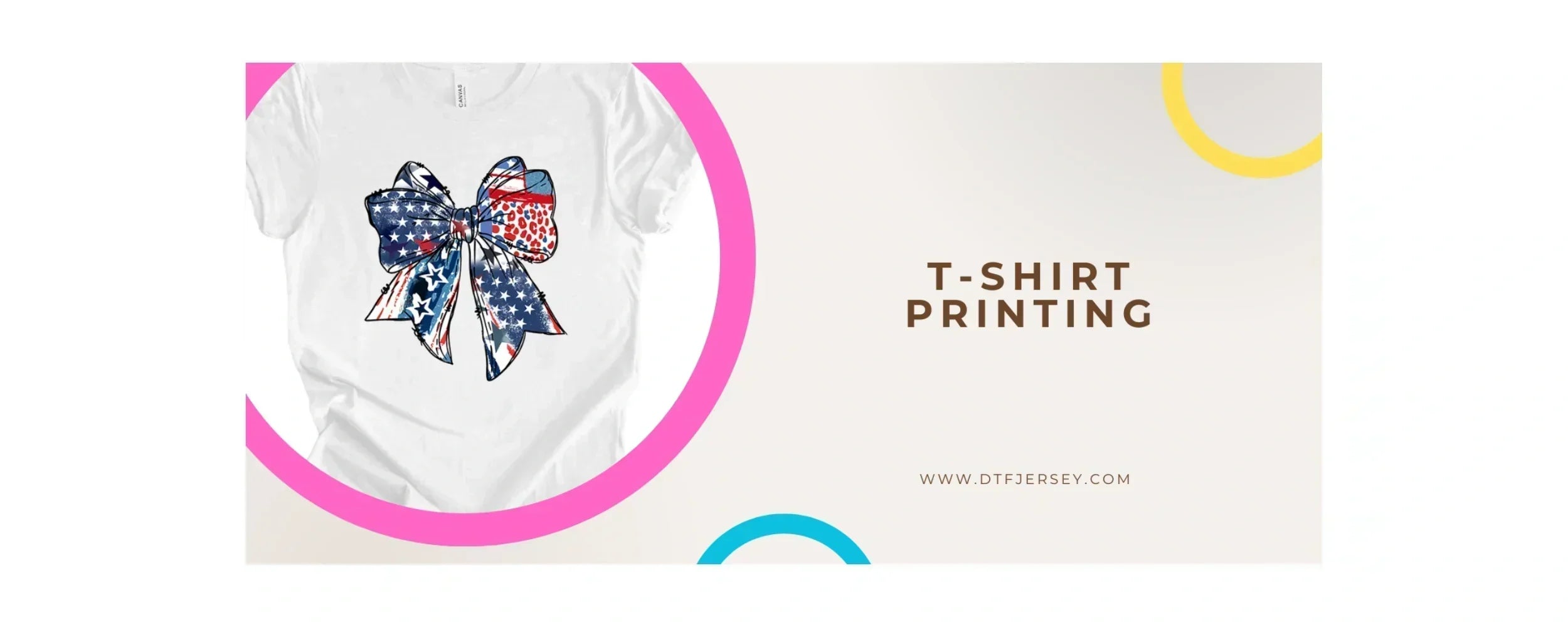Article: DTG vs. DTF Printing: Which One's Better?

DTG vs. DTF Printing: Which One's Better?
When it comes to custom printing, choosing between DTF vs DTG transfer types can be hard and confusing. Each method offers unique benefits depending on your project needs. In this comprehensive guide for DTG vs DTF printing methods, you will learn the main differences, strengths, and ideal use cases of both methods, and facts based point of view to help you make the best decision for your printing needs.
What is the Difference Between DTF and DTG Printing?
The main difference between DTG and DTF printing lies in how the ink is applied. DTG, which is Direct to Garment, prints ink directly onto the fabric, while DTF, Direct to Film, transfers designs from a film onto the fabric using heat. DTG is ideal for cotton fabrics and soft-feel prints. On the other hand, DTF works well on a wider variety of fabrics and provides stronger colors.
Which is Better: DTF or DTG?
The answer to this depends on your requirements. If you want vibrant colors and flexibility across fabric types, DTF may be better. But if you prioritize a soft, breathable print on 100% cotton, DTG may suit you more. For small orders or intricate prints, DTG should work well. Otherwise, DTF is excellent for different fabrics and bulk orders.

Is DTF Printing More Durable than DTG?
DTF prints tend to be more long lasting than DTG, despite multiple washes. The adhesive powder used in DTF creates a stronger bond between the design and fabric. DTG prints may fade quicker if not properly taken care of, as the ink is absorbed directly into the fibers. In the debate of DTG vs DTF durability, DTF has a slight edge for long-term wear and wash performance.
Can I Use DTF and DTG on the Same Fabric?
From a technical angle, both DTF vs DTG can be used on the same fabric, particularly cotton and cotton blends. However, using both methods on the same piece is not typical or recommended. Each technique has its own preparation and finish, so mixing them might affect consistency. If you are comparing direct to film vs direct to garment use on a single garment, it may be wise to choose one printing type based on your desired goal and output.
Pros and Cons of DTF Printing
DTF printing has many pros:
- It works on a variety of fabrics including polyester, cotton etc
- It provides vivid colors, and doesn't require pretreatment.
- It is also perfect for fine details.
- It is great for bulk orders and saving on costs
While it also has some cons:
- It gives a slightly plastic feel on the fabric
- It is a more complex process involving film, powder, and heat
- It is requires higher initial investment
- It is slower in production pace
Pros and Cons of DTG Printing
Pros of DTG Printing:
- DTG printing delivers soft, breathable prints which are ideal for cotton garments.
- It allows for high-resolution designs with fine details.
- It is fit for small orders or single custom designs
Cons of DTG Printing:
- DTG printing is primarily suited for cotton fabrics, often requires pretreatment, and may experience quicker fading over time—especially without following proper printed garment care instructions.
- The initial equipment cost is also high.
- It is not a good option for bulk production
Which Printing Method is Cost-Effective for Small Businesses?
As a small business owner, cost-effectiveness depends on the order volume and garment and garment printing types. DTF is mostly more affordable for bulk orders and gives more flexibility with fabric options. DTG, however, is easier for quick, low-volume jobs. When looking at DTG vs DTF vs screen printing, DTF often offers the best balance of cost and versatility.

Does DTF or DTG Work Better on Dark Fabrics?
DTF performs well on dark fabrics without much extra work. It doesn’t need pretreatment and still provides vibrant results. DTG also works on dark garments, but only after pretreatment, which can affect production time and cost. So, for printing on dark materials with ease, DTF has the advantage and is more efficient for consistent quality across all colors.
Are the Colors More Vibrant with DTF or DTG?
DTF normally generates more vibrant colors compared to DTG. The use of film and adhesive powder in DTF improves ink brightness and opacity, like on dark or synthetic fabrics. DTG prints can look slightly faded or muted on some materials, if you don’t make perfect settings.
Which Method Lasts Longer After Multiple Washes?
DTF prints hold up better after repeated washing. The adhesive creates a durable bond that resists cracking or fading. DTG prints can maintain quality if you handle them with care but are more sensitive to washing conditions. When it comes to longevity, DTF often outperforms.
Is DTF Printing Good for Detailed Designs and Fine Lines?
Yes, DTF printing is excellent for detailed artwork and thin lines. The film-based DTF transfer allows for precise ink placement, preserving fine design elements. DTG also handles detail well but may bleed slightly on certain fabrics. If your project includes logos, text, or intricate patterns, DTF produces sharper and more defined results.
Is DTF Printing Environmentally Friendly Compared to DTG?
Both DTF vs DTG have environmental impacts, but DTG is more eco-friendly in general. It uses water-based inks and produces less waste since it prints directly onto garments. DTF involves plastic film and powder, which can contribute to waste if not managed properly. For sustainable printing goals, DTG may have a small advantage; however it depends on practices and materials used.
Do I Need Pretreatment for DTG and DTF Printing?
Yes for DTG but not for DTF. DTG printing requires pretreatment for dark fabrics, to help the ink bond correctly and appear vibrant. DTF printing skips this step entirely, which saves time and labor. This difference also influences turnaround time and cost. The need for pretreatment in DTG can make DTF more appealing for faster, and simpler production.

Which Method is Better for Bulk Orders?
Between DTF vs DTG types, DTF printing is better suited for bulk orders. Its process is quicker once set up, and transfers can be prepared in advance. Plus, DTF doesn’t require pretreatment, which saves time. DTG works well for smaller quantities but can be slower and more labor-intensive for high-volume jobs. If your business focuses on large-scale production, DTF offers better speed and consistency.
FAQs
You can find more frequently asked questions and answers about DTF vs DTG further down the page.
Does DTF last as long as DTG?
In the DTF vs DTG comparison, DTF often lasts longer due to its strong adhesive layer, resisting wear and washing better than standard DTG prints.
Which is better, DTG or DTF?
Choosing between DTG vs DTF printing depends on your needs; DTF is more versatile on fabrics, while DTG provides a softer feel on cotton garments.
Is DTG or DTF better?
Both DTF vs DTG transfer types have strengths; DTF suits bulk and diverse materials, while DTG is ideal for small runs on cotton. The better option depends on your printing priorities.
Is DTF printing good quality?
Yes, DTF printing delivers high-quality, vibrant designs with sharp details. It is mostly good for bold colors and works well across a range of fabrics.
What is DTF printing?
DTF printing is a method that transfers ink from film to fabric using heat. Unlike DTG, it works on more fabric types and doesn’t need pretreatment.

